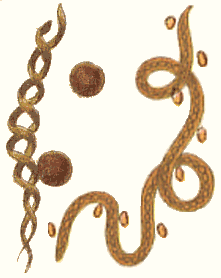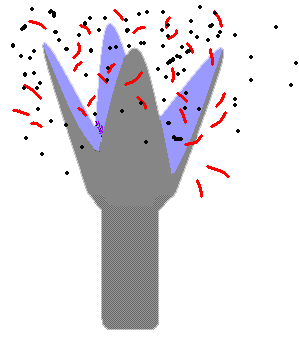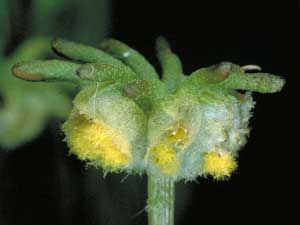 Elaters and spores from Jungermannia sphaerocarpa (left) and Pellia epiphylla (right). Taken from two plates in G. Hahn's Die Lebermoose Deutschlands, 1885. |
Reproduction & dispersal
Elaters in liverworts
Within the spore capsules of many liverwort species there are elaters as well as spores. Elaters are tubular cells with spiral thickenings and often help in spore release. This photo ![]() shows two spores and elaters of Fossombronia foveolata. Both spores are broken and exuding oily droplets. This photo
shows two spores and elaters of Fossombronia foveolata. Both spores are broken and exuding oily droplets. This photo ![]() shows part of a broken spore capsule of the thallose liverwort Fossombronia papillata. As well as elaters you can see spores (the round dark brown objects) and fragments of the spore capsule wall (the flat, often brown-speckled sheets).
shows part of a broken spore capsule of the thallose liverwort Fossombronia papillata. As well as elaters you can see spores (the round dark brown objects) and fragments of the spore capsule wall (the flat, often brown-speckled sheets).
Elaters do not work in the same way in all species and there are some species where elaters play little or no role in spore release. On this page you'll see how elaters are arranged and how they work in several species. While many liverworts have elaters there are exceptions. For example the thallose genera Sphaerocarpos ![]() and Riccia
and Riccia ![]() lack them and some populations of Fossombronia microlamellata, another thallose liverwort, lack elaters
lack them and some populations of Fossombronia microlamellata, another thallose liverwort, lack elaters![]() .
.
Cephalozia bicuspidata is a leafy liverwort, widespread in the Northern Hemisphere. The left hand figure in the following diagram shows an unopened spore capsule, which is elongated in this species. The red lines are the elaters, each attached at one end to the inner wall of the spore capsule. Each of the red elaters is coated with black spores.
 |
 |
Four lines of weakness run along the wall of the capsule, which opens out into four lobes. Once the capsule has opened the contents begin to dry out. Each elater has two spiral bands and is filled with water. The water in each elater begins to evaporate so that the elater becomes distorted, with the thinner areas between the spiral bands being sucked inward. The whole elater also becomes twisted into a tight helix and naturally the spiral bands become distorted as well, but they always have a tendency to untwist. However, this is resisted by the cohesion of the water molecules still inside the elater and their adherence to the inner wall of the elater. This puts the water under increasing tension, until the water can be stretched no more. It breaks, and the elater immediately returns to its original shape and volume. In doing so it untwists so violently that it breaks free from the capsule wall and springs into the air, ejecting its load of spores in the process. That's shown in the right-hand figure above. The Cephalozia water-rupture mechanism has been observed in a number of other leafy liverwort genera and considerable tension can have built up in the water column just before it ruptures, for example 200-300 atmospheres found in a study involving the genus Lophozia.
Considerable force is also at work in the leafy liverwort Frullania dilatata but the workings of the elaters are quite different to those of the preceding example. The following sequence of diagrams shows the Frullania spore release process.

On the left is the closed, spherical spore capsule where, once again, the red lines show the elaters. In this species the elaters are attached at both ends. The capsule opens along four lines of weakness and the second diagram shows two of the capsule's four lobes shortly after opening. At this point the elaters are still attached at both ends, but stretched and clearly under tension. A little later the elaters break off suddenly and simultaneously at the ends nearer the seta. The elaters are flung to a nearly vertical alignment and the lobes of the spore capsule also bend out further. These sudden movements fling the spores 1 to 2 centimetres into the air. The elaters, now free at one end, may twist slightly as they dry. However, this happens after the majority of spores have been released and so the twisting contributes very little to spore release.
In some liverworts the spores are actively discharged by elater movements, but without the explosive forces shown in the Cephalozia and Frullania examples. The elaters twist or untwist, depending on whether the surrounding air is drying out or becoming moister. Marchantia is an example of this. The spore capsules are held under some form of umbrella-like structure and hang down, on very short stalks. A mature capsule splits open, with short lobes folding back to reveal a globose mass of spores intermixed with long, straight elaters that are vertically aligned. As these begin to dry out they twist and become entangled with each other. Strains develop in such entangled elaters as they twist further and pull on each other. From time to time one elater or another may suddenly free itself from its neighbours and do so with a sudden, jerky movement that throws the associated spores into the air. The elaters themselves are rarely thrown off.
The elaters of Pellia have fairly weak spiral thickenings and move only very feebly in response to changes of humidity. However Pellia capsules are held up by long setae and the spores are released from the elaters simply by strong breezes. In liverworts where there is very little elater movement, the limited elater movement is at least likely to loosen the spore mass, and so make it easier for the spores to be dispersed by wind.
Mosses and hornworts
Mosses lack elaters.
Within a developing hornwort sporophyte the developing spores are mixed with sterile cells of varying form. These may be single-celled or multi-celled and branched (liverwort elaters can be branched as well) or unbranched. Some bryologists call all such structures pseudoelaters, while others hold that some true elaters are present in some hornwort species. Note that by the definition of elaters as single-celled, the multi-celled sterile cells within hornwort sporophytes cannot be elaters – leaving just the single-celled sterile cells subject to debate. As with the liverworts, the elaters or pseudoelaters of the hornworts play varying roles in spore dispersal.
![An Australian Government Initiative [logo]](/images/austgovt_brown_90px.gif)


